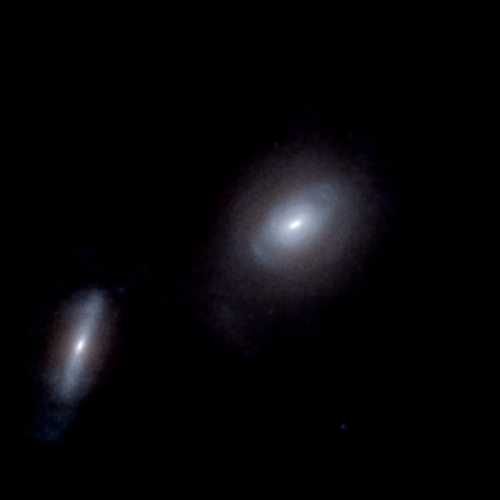Gravitation Waves Arise Earlier than Expected
7. October 2016
An international team of astronomers with Heidelberg participation calculates the appearance of gravitational waves after the collision of two galaxies

Source: Astrophysical Journal
This simulation documents four phases during the merging of two galaxies over a period of about 15 million years.
If two galaxies collide, the merging of central black holes creates waves of gravitation that ripple across the whole universe. So far scientists have not been able to conclusively say when exactly these waves are released. An international team of astrophysicists from Zürich University, the Institute of Space Technology Islamabad, the Chinese Academy of Sciences and Heidelberg University has now calculated this point in time using computer simulations. They found that gravitation waves occur about ten million years after the galaxies merge and thus much faster than so far assumed.
As the Heidelberg astrophysicist Prof. Dr. Andreas Just explains, each galaxy has a super-massive black hole at its core that can exhibit a mass of millions or even billions of solar masses. Using super computers, the scientists have now simulated the merging of two galaxies in the universe, which is about three billion years old. They calculated the time that the two central black holes with about 100 million solar masses needed to merge after the collision of the galaxies and emit strong gravitational waves.
The computer simulations, which took over a year, were also conducted at Heidelberg University. “The project called for an innovative computational approach with different numerical codes that were used on various super-computers,” declares Andreas Just from the Institute for Astronomical Computing, which is part of the Centre for Astronomy of Heidelberg University (ZAH). Every high-powered computer was responsible for calculating a certain phase of convergence of the two massive black holes and their parent galaxies.
The scientists say that the result of the study is really surprising. It only took ten million years for the two black holes to trigger strong gravitational waves after having merged – so this happened 100 times more quickly than previously assumed. Compared to previous models, the current simulation also included the relations between the orbits of the central black holes and the structure of parent galaxies. The calculations therefore permitted a robust prognosis for the merging rate of super-massive black holes in the early stage of the universe.
The research results were published in the Astrophysical Journal. Fazeel Mahmood Khan, the first author, is professor at the Institute of Space Technology in Islamabad in Pakistan. He earned his PhD at the Astronomy Centre in Heidelberg in 2011, with Prof. Just as his supervisor.

